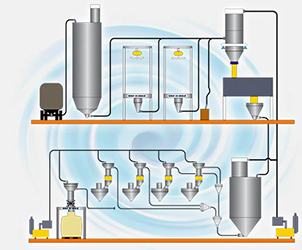
As all processes vary, so does the technology used to move granular bulk materials and dusty powders from source to destination. Here are ten things to consider when designing a vacuum conveying system:
1. Know your Bulk Density
Bulk density is measured in pounds per cubic foot or gm/cc. To convert from gm/cc to #/ft2 multiply by 62.43. Doing this, helps in calculating the size of the vacuum receiver, as well as the size of the vacuum power unit and how many CFM is needed.
2. Conveying Distance: Horizontal or Vertical?
When designing a pneumatic conveying system for handling various powders, dusty powders, or granular bulk materials, find out how many 90-degree sweeps are needed. Typically, one sweep equals 20 feet of linear tubing or pipe. For example, 20 feet vertically, and 20 feet horizontally. In batch or continuous systems, watch for in-flight bulk material that may fall back down into the conveying line. A line clearing valve is recommended.
3. Know the Conveying Rate
When designing a pneumatic conveying system, it is important to know how many pounds/kilograms per hour will be conveyed. It is also important to know whether the application is a batch operation. For example, if the application requires to convey 2,000 pounds per hour, but actually the process requires conveying 2,000 pounds once an hour in 5 minutes, resulting in an actual convey rate of 24,000 pounds per hour.
4. What are the Material Characteristics?
This is the most important step when designing any process automation solution. Find out if the powder or bulk material is free flowing, cohesive, is it a powder, a pellet, flake, granule, glass fiber, or hygroscopic. Bulk material evaluation includes finding the bulk density, flow angles, sieve analysis, can velocity, terminal velocity, bulk velocity, fluidity, abrasion, and particle shape. It is important to know that the characteristics of powders vary from fluidizable to bridge-building. Powders can be free-flowing, cohesive, to very abrasive. Typical filler powders such as talc or calcium carbonate, are received via bag dump station or bulk bag unloading station. A fluidizing cone, rotary valve, or volumetric pre-feeder assist with the movement at the pick-up point.
5. How is the Bulk Material Received?
Typically, any type of powder or bulk ingredient is received in an bag, drum, bulk bag or FIBC (flexible intermediate container), RIBC (Rigid intermediate container), Mixer, Silo, or Day Bin.
6. What is the Process Equipment?
Find out if the bulk material is being conveyed to a loss-in-weight feeder, volumetric feeder, mixer, extruder hopper, reactor, blender, or other related equipment. Keep in mind that upstream equipment effects downstream equipment. The more that is known about the process application, the better. For example, knowing what process equipment is being loaded beforehand, like a loss-in-weight feeder that needs to be refilled quickly, effects the design of the system.
7. How Much Headroom is Above the Process Equipment?
It is important to know how much headroom is available above the process equipment. Even the smallest vacuum conveying system for powders will require at least 30” of headroom. Headroom constraints can be worked around. Cyclones or filter-less vacuum receivers can be employed, or scaling valves and even positive pressure systems.
8. Is the Process a Batch or Continuous Operation?
Typically, in an extrusion process, the process automation system will be a batch operation. The process equipment is loaded either via a volumetric or loss-in-weight feeder, with feeder metering the powders, additives, etc., continuously into the extruder.
9. Geographically, where is the plant site?
It is important to find out how many feet above sea level the site is located. The higher the elevation, the less air, and this effects the vacuum source sizing. For example, if a factory is located at shore points, or at sea level, a 5 HP vacuum pump may be used. A factory in Denver, Colorado may require a 7.5 HP vacuum pump.
10. Material of Construction
Before designing any process automation solution, it is important to know the material of construction, specifically carbon steel, stainless steel (304 or 316L), or pharmaceutical sanitary grade.
By properly defining these points plant, processing and production operations will be maximized, ultimately improving energy efficiency. It is always important to check all convey lines for leaks, this is the main cause of wasted energy. Each system should be tailored for a pick-up velocity specific to the material characteristic.
Doing so avoids material build-up in the line, and potential higher energy consumption. It is also important to make sure all filter elements are clean and make certain that the system is not running after the hopper is emptied, again potential for unnecessary energy consumption.
This article was contributed by Vac-U-Max.
Print this page
